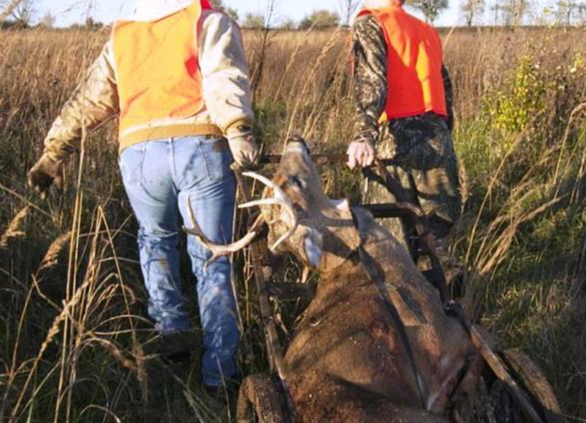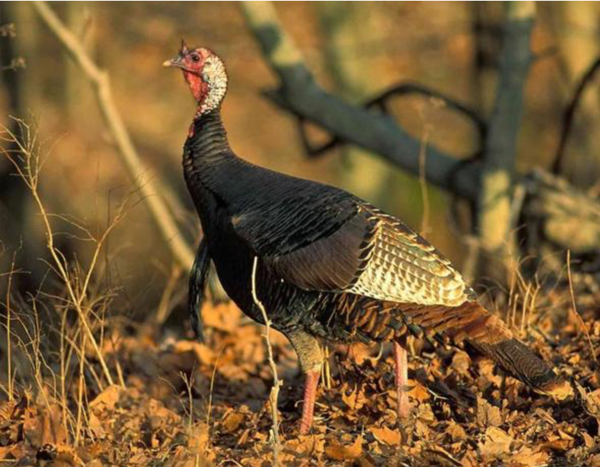
Top harvest counties were Howell, Franklin, and Texas.
Missouri - Preliminary data from the Missouri Department of Conservation (MDC) shows that deer hunters in Missouri harvested 185,066 deer during the November portion of fall firearms deer season, Nov. 12-22. Of the 185,066 deer harvested, 95,383 were antlered bucks, 18,889 were button bucks, and 70,794 were does. Top harvest counties were Howell with 3,910 deer checked, Franklin with 3,738, and Texas with 3,562.
Last year, hunters checked 186,542 deer during the 2015 November portion of firearms deer season with 90,094 being antlered bucks, 20,911 being button bucks, and 75,537 being does.
MDC reported three firearms-related hunting incidents during the fall firearms November portion. Two of the three incidents involved self-inflicted firearm wounds and occurred in Barry and Camden counties. The third involved one hunter in a party in Grundy County wounding another while shooting at a deer.
Deer hunting in Missouri continues with archery deer hunting from Nov. 23 through Jan. 15, firearms late youth portion Nov. 25-27, firearms antlerless portion Dec. 2-4, and firearms alternative methods portion Dec. 24 through Jan. 3.

Top harvest counties for opening weekend were Franklin, Howell, and Texas.
Missouri - Preliminary data from the Missouri Department of Conservation (MDC) shows that deer hunters in Missouri harvested 96,131 deer during the opening weekend of the November portion of the fall firearms deer season Nov. 12 and 13. Of the 96,131 deer harvested, 55,753 were antlered bucks, 8,873 were button bucks, and 31,505 were does.
Top harvest counties for opening weekend were Franklin with 2,041 deer checked, Howell with 1,950 and Texas with 1,939.
Last year hunters checked 97,002 deer during the opening weekend of the 2015 November portion of firearms deer season.
The November portion of fall firearms deer seasons continues through Nov. 22. Archery deer season opens again Nov. 23 through Jan. 15, 2016. The late youth portion of firearms deer season runs Nov. 25-27. The antlerless portion of firearms deer season runs Dec. 2-4. Lastly the alternative methods portion will run Dec. 24- Jan. 3, 2017.
Missouri offers some of the best deer hunting in the country and deer hunting is an important part of many Missourians’ lives and family traditions. Deer hunting is also an important economic driver in Missouri and gives a $1 billion annual boost to the state and local economies.
Article by the Missouri Conservation Department. Provided photo of Dace Wisdom and his first deer!

Congratulations to Mark McArtor on breaking the state record by catching a 9-pound, 1-ounce hybrid striped bass with a jug line on the Lake of the Ozarks.
Camdenton, Missouri - The Missouri Department of Conservation (MDC) reports that Mark McArtor of Camdenton became the most recent record-breaking angler in Missouri when he caught a hybrid striped bass on the Lake of the Ozarks.
The new “alternative method” record hybrid striped bass caught by McArtor on Oct. 31 weighed 9-pounds, 1-ounce with a length of 27 inches. McArtor caught the fish with a jug line in front of his house on the lake.
“My wife and I are thrilled to have caught a state record fish,” McArtor said. “I still can’t believe it!”
McArtor said he was using shad for bait trying to catch blue catfish when he caught the large hybrid striped bass.
“This wasn’t the first hybrid striped bass we caught,” he said. “We actually caught a pretty decent sized one last year, but it didn’t meet the qualifications for the Department’s master angler program.”
MDC staff verified the record-weight fish using a certified scale in Camdenton. This is the 15th state record fish caught this year by an angler.
“A state record fish can be caught any time of the year, but we normally do not receive many state record fish applications once summer is over, “said MDC Fisheries Programs Specialist Andrew Branson. “But since the weather has been warmer this year a lot people are still fishing, which means a better chance of someone catching a state record fish.”
McArtor noted he hopes to catch more state record fish like this one with his wife.
“Catching another state record would be great, but really I am just happy with what the lake provides,” McArtor said.
Missouri state-record fish are recognized in two categories: pole-and-line and alternative methods. Alternative methods include: throwlines, trotlines, limb lines, bank lines, jug lines, spearfishing, snagging, snaring, gigging, grabbing, archery, and atlatl.
Photo and article submitted by the Missouri Conservation Department.

The Missouri Department of Conservation (MDC) announced that hunters checked 3,698 turkeys during Missouri’s fall firearms turkey season, Oct. 1-31. Last year’s fall firearms turkey harvest total was 6,158. Top harvest counties for the 2016 fall firearms turkey season were Greene with 128, Franklin with 96, and Wayne with 92.
MDC’s turkey biologist says this year’s low fall firearms turkey harvest total can be attributed to several factors, including a poor turkey hatch, above-average acorn production, and a decline in hunter participation.
“This year’s turkey hatch was very poor, so there were far fewer young birds for hunters to pursue this fall,” said MDC Turkey Biologist Jason Isabelle. “We had above-average acorn production in much of the state this year as well, which typically results in fewer turkeys being harvested.”
In addition to the effects of a poor turkey hatch and above-average acorn production, interest in the fall firearms turkey season has been declining in Missouri as it has in a number of states.
Isabelle noted, “This year’s fall firearms turkey permit sales total of 11,696 permits was the lowest on record since the season started in 1978.”
Fall archery turkey hunting continues through Nov. 11 and then resumes again from Nov. 23 through Jan. 15, 2017.

This year’s annual wild-turkey brood-survey shows statewide turkey production in 2016 was lower than the five-year average – likely due to poor nesting success.
“Although we didn’t have many days with heavy rainfall in much of the state this spring, we did have quite a few days with at least some precipitation,” said MDC Turkey Biologist Jason Isabelle. “When hens are repeatedly getting wet while incubating, it can increase the chances of a predator locating the hen and her nest. Looking at this year’s brood survey results, only 29% of hens were observed with poults, which indicates poor nest success.”
Isabelle added June was fairly dry and ideal for brood-rearing in much of the state, but there were relatively few poults that were able to benefit from those conditions due to low nest success this year.
“Despite a poor hatch this year, there are still more turkeys on the landscape in many areas of the state compared to five years ago,” Isabelle said.
Each summer, citizen volunteers and MDC staff record the number of wild turkey hens and recently hatched turkeys, called poults, they see. These observations are then tallied for the annual brood survey. The number of poults is divided by the number of hens reported to create a poult-to-hen ratio (PHR). Isabelle explained this is a good measure of turkey nesting success and poult survival.
“Each year, thousands of citizens participate in the survey and we are grateful for their contribution,” Isabelle said. “During the three-month survey, participants typically report sightings of 60,000-80,000 turkeys, which is a testament to the large number of dedicated volunteers that take time to participate in the survey.”
This year’s statewide PHR was 0.8, which was below last year’s figure of 1.5 and the previous five-year average of 1.6. Regionally, PHRs this year ranged from 0.8 in the Northeast, Union Breaks, and West Prairie turkey productivity regions to 1.3 in the Mississippi Lowlands region (see image).
Given the poor hatch throughout the state, Isabelle says fall turkey hunting is going to be more challenging this year.
“Having fewer young birds on the landscape this year will likely result in hunters having to put forth more effort to be successful. This will be especially true in areas that experience good acorn production,” he said.
Isabelle notes where acorns are abundant, turkeys spend more time in forested areas and do not have to range far to locate food, both of which typically result in reduced turkey harvest.
In addition to considering this year’s hatch, Isabelle says hunters should be mindful of trends in regional turkey numbers. During the last five years, turkey numbers have been increasing in portions of north-central Missouri, as well as in the Ozark Border, Ozarks East, and Ozarks West regions (see image).
“Although the 2016 fall prospects are not as positive as years past, October is still a great month to enjoy the outdoors, and fall hunting provides an opportunity to pursue turkeys in the setting of Missouri’s beautiful fall woods, such as MDC’s conservation areas,” Isabelle said.
“Unlike the spring season, when more than 100,000 turkey hunting permits are purchased in Missouri, typically fewer than 15,000 hunters purchase fall firearms turkey permits,” he added.
Results of the 2016 wild turkey brood survey are available at http://on.mo.gov/2di1PXI.
Fall archery turkey hunting continues through Nov. 11 and resumes again Nov. 23 to Jan. 15. Shooting hours are one-half hour before sunrise to one-half hour after sunset with a limit of two turkeys of either sex. Fall firearms turkey season runs Oct. 1-31 from one-half hour before sunrise to sunset with a limit of two turkeys of either sex. Details about fall turkey hunting regulations are found in the 2016 Fall Deer and Turkey Hunting Regulations and Information booklet available wherever hunting permits are sold, from MDC offices and nature centers, or online at http://on.mo.gov/2d7JPxc.
Buy permits from vendors around the state, online at mdc.mo.gov/buypermits, or through MDC’s free mobile apps, Mo Hunting and Mo Fishing, available for download through Google Play for Android devices or the App Store for Apple devices.

